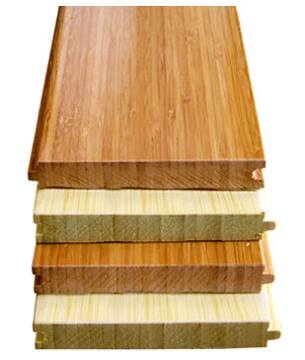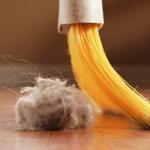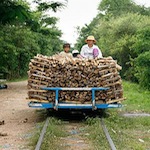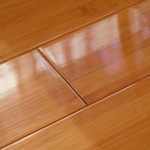Bamboo Flooring Pros and Cons

Bamboo Flooring Pros and Cons
Bamboo has come on the scene for many uses in the home building industry, including hardwood flooring.
It is quickly becoming a preferred flooring material for homeowners, interior designers and architects.
It is very beautiful and durable, but there are certain elements that you should be aware of when selecting bamboo for your home floors.
Bamboo flooring provides many "green" characteristics, a few of its positive and also negative attributes are listed below.
Bamboo Flooring Pro and Cons - The Advantages
Bamboo is Rapidly Renewable: Bamboo Flooring rise in popularity can be attributed to its rapidly renewable nature. It is rapidly renewable because of its fast growth. Bamboo is actually a grass and does not have to be replanted after harvesting because it regenerates itself from its roots. Selected bamboo varieties can reach growth rates of up to twelve inches per day. In contrast, a typical hardwood tree can take anywhere between 50-120 years to reach full maturity. And with most bamboos, the harvest cycle is between 3-7 years. You can now understand why bamboo is gaining notoriety as a miracle flooring option.
Visual Appeal and Presentation: In many cases bamboo flooring looks better than its hardwood flooring counterparts. Bamboo, by its nature has a natural and earthy feel to it.
Very Durable: Bamboo that is harvested around its 5th or 6th year of growth or longer are very dense and strong. It is equally as strong as many other hardwood floors that are ordinarily used for flooring. Certain species of bamboo have hardness ratings that nearly always exceed maple and can approximately double that of red oak hardness.

Easy Care Aspects of Bamboo
Spill Resistant: Bamboo flooring is also naturally water and moisture resistant as opposed to hardwood floors, making it a perfect material for kitchens, dining rooms and bathroom floors.
Easy Care: An additional pro is bamboo flooring is very simple to care for. To keep bamboo floors looking like brand new, keep dirt and dust picked up by regular sweeping or vacuuming. And because bamboo is a water resistant material you can use a wet mop at weekly or bi-weekly intervals.
Bamboo Flooring Pros and Cons - Disadvantages:
There are some negative aspects to bamboo flooring as well. While sometimes it is easier talking about a products virtues, it is significant to realize some of the negative qualities of a product as well. Therefore, we will discuss some of the negative aspects below.

Bamboo From China
Bamboo is Typically Shipped Great Distances: Most bamboo is grown in China, where it is a native species. This means that it needs to be shipped great distances to reach consumers outside the Asian Continent.
As we all know, it takes a tremendous amount of energy to process, pack and ship items to the United States. There is good news though, Horticulturalists think that someday bamboo could be grown in the USA. This development of locally grown bamboo would be a benefit in decreasing the need for long distance shipping.
VOC's In Glue and Finish: Be careful in the selection of bamboo manufacturers as well. Some of the bamboo on the market utilizes finishes and glues that have a high levels of VOC's. Volatile organic compounds or VOC's are very unhealthy for both the installing contractors, and even more unhealthy for the home occupants. Since VOC's off-gas for several years after the installation, it negatively affects the indoor air quality of the home.
Being exposed to excessive VOC's has been documented to cause adverse health issues so avoid them and try to find a product that is formaldehyde free. Prior to the purchasing your bamboo product, be sure to examine the MSDS sheets, which are the Material Safety and Data Sheets. They will list all of the VOC information.
Questionable Labor Practices:Most bamboo that is used in flooring is produced in China and other similar countries where labor practices are questionable and undocumented. Many overseas companies do not have guidelines for the products they sell. Because of this, many by products from the manufacturing process can be dumped into local rivers and streams.

Be Aware of Finish Problems
Inferior Bamboo Products: Inferior Bamboo Products: There are some poor bamboo flooring products available in the market. Make sure that research is done so quality products are selected. Search for bamboo that has been allowed to fully mature through 5 years of growth. Bamboo that is harvested before 3 years is not nearly as long-lasting as mature bamboo. Cheaper usually means defective or very soft when it comes to bamboo flooring. Watch out for cheap products that are priced too good to be true. They usually are!
Finish Fading: One last negative aspect of bamboo flooring is that the finish may fade or discolor. This is a common problem for all wood floors, and not just specific to bamboo. While there are new UV resistant finishes being applied to all floors, it would be beneficial to minimize exposure of your floor to prolonged periods of direct sunlight.
For those who are looking for an eco-friendly flooring option, bamboo is a outstanding choice, but it is important to weigh the pros and cons of using it. The pros far outweigh the cons - but it is important to do the research before making a final decision.
comments powered by Disqus

























































































































































































